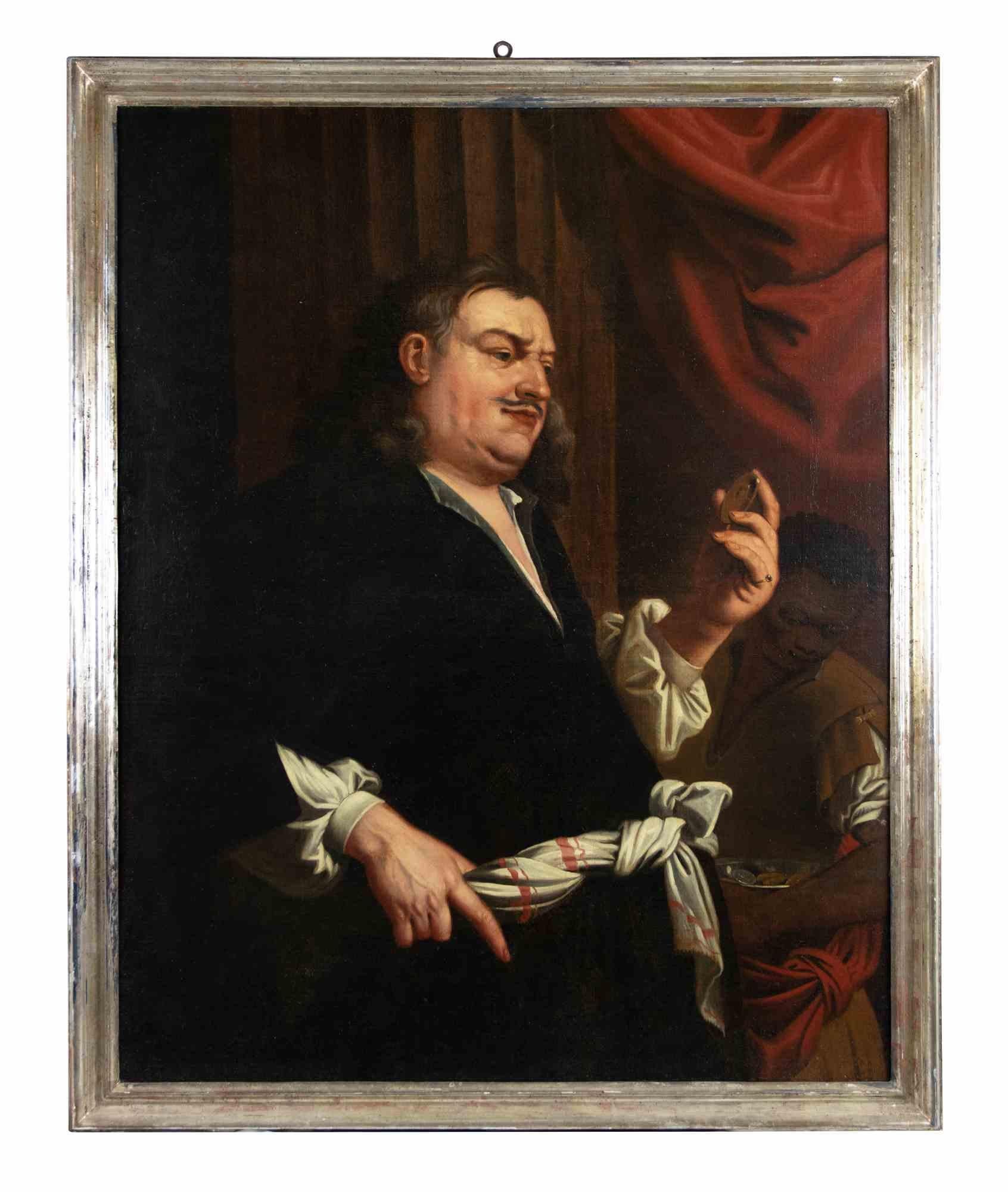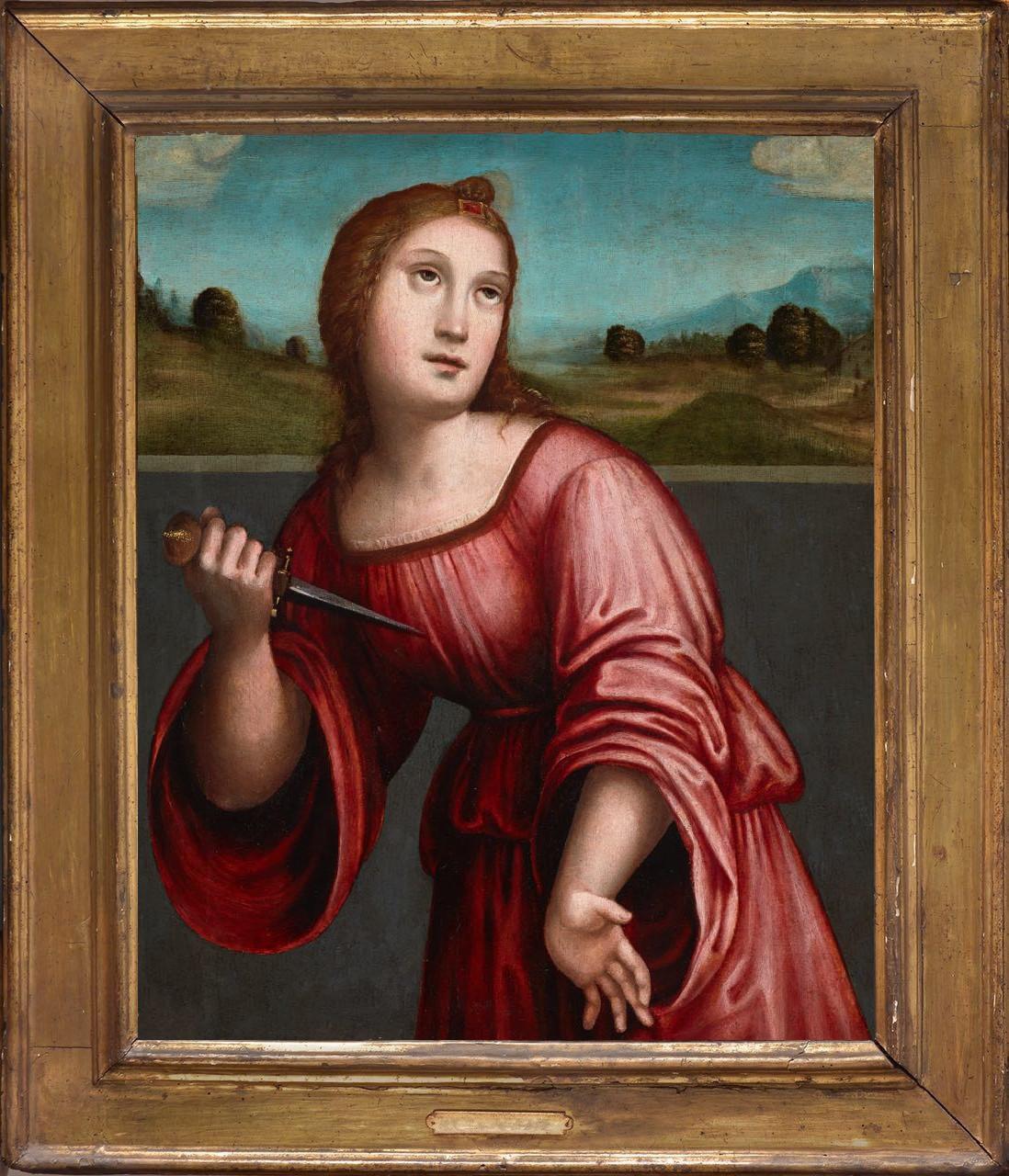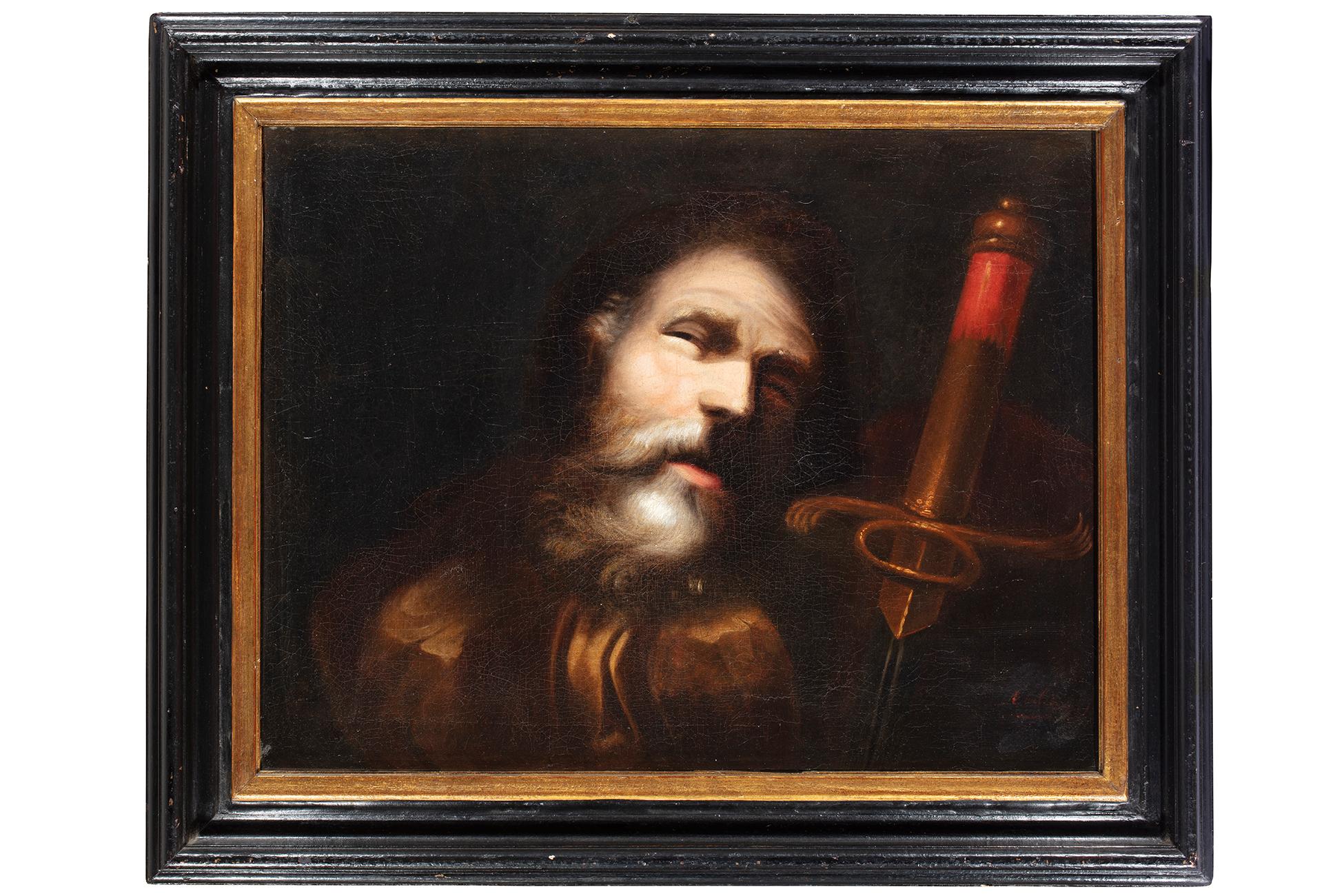Items Similar to Portrait of a Gentleman with his Dog - Possibly Abraham Tucker. Oil on Canvas
Want more images or videos?
Request additional images or videos from the seller
1 of 9
Portrait of a Gentleman with his Dog - Possibly Abraham Tucker. Oil on Canvas
About the Item
Enoch Seeman - 1894 - 1744
An excellent example of Seeman's work. It is typically unsigned as was the case of many portraits of that time. A three quarter length portrait showing a rich upper classed man with beautiful and expensive clothing. He is holding a riding crop and has a beautiful hound looking up at his master.
Provenance: Christies King Street
Canvas Size: 50 x 40" (127 x 102cm)
Outside Frame Size: 58 x 48" (147 x 122cm)
He was born in Danzig, now Gdansk, Poland, around 1694. His father, also Enoch was born around 1661, and the Seeman family were painters.
Having been brought to London from his home of Flanders by his father in 1704, the younger Seeman's painting career as we know it began with a group portrait of the Bisset family in the style of the portraitist Godfrey Kneller, now held at Castle Forbes in Grampion Scotland, and dated by an inscription 1708.
As a painter to the British royal court Seeman the Younger completed portraits of George 1, in 1730, in the robes of his coronation and of George II some years later. The first of these pictures is held at the Middle Temple in London, England, and the second is at Windsor Castle in Berkshire, England, part of the royal collection.
In 1734, Seeman painted a portrait of Jane Pratt Taylor, daughter of Lord Chief Justice John Pratt. The portrait was sent to William Byrd II of Westover, in Virginia, where it became part of the largest colonial portrait collection of the early eighteenth century. The painting is now part of the collection of the Virginia Historical Society.
The Yale University Art Gallery owns a portrait of Elihu Yale in 1717 by Seeman and the Metropolitan Museum in New York, USA owns his rendering of Sir James Dashwood, described by the Grove Dictionary of Art as 'Exceptionally lively'. Also by Seeman the younger, Abraham Tucker in 1739 at the National Portrait Gallery in London, England, and various copies of sixteenth and seventeenth century portraits.
The National Trust owns two examples of this set of his work – at Dunham Massey in Cheshire, England, a copy of a portrait of Lady Diana Cecil, and at Belton House in Lincolnshire, England, of Lady Cust and her nine children. Dresden and Hanover museums have also displayed his work.
- Attributed to:Enoch Seeman (1694 - 1744, Polish)
- Dimensions:Height: 58 in (147.32 cm)Width: 48 in (121.92 cm)Depth: 3 in (7.62 cm)
- Medium:
- Movement & Style:
- Period:1730-1739
- Condition:It is in good condition with a hand made frame and has benefited from a high quality reline and a light clean.
- Gallery Location:St. Albans, GB
- Reference Number:1stDibs: LU2469214420532
About the Seller
5.0
Gold Seller
These expertly vetted sellers are highly rated and consistently exceed customer expectations.
Established in 1965
1stDibs seller since 2023
20 sales on 1stDibs
Typical response time: 1 hour
- ShippingRetrieving quote...Ships From: St. Albans, United Kingdom
- Return PolicyA return for this item may be initiated within 7 days of delivery.
More From This SellerView All
- A Portrait of a Bewigged GentlemanBy Enoch SeemanLocated in St. Albans, GBEnoch Seeman Canvas Size: 30 x 25" (76 x 62cm) Outside Frame Size: 37 x 32" (92 x 80cm) 1694-1744 He was born in Danzig, now Gdansk, Poland, around 1694. His father, also Enoch...Category
Early 18th Century Old Masters Portrait Paintings
MaterialsOil
- The RoseLocated in St. Albans, GB'The Rose' Canvas Size: 38.5 x 28" (98 x 71cm) Outside Frame Size: 48.5 x 38 (123 x 97cm) Oil on canvas Emile CHARLET 1851 - 1890 Born 1851 in Belg...Category
1870s Impressionist Figurative Paintings
MaterialsOil
- The Rose SellerLocated in St. Albans, GBAlfred Edward Emslie A beautiful example of Arthur Emslie's work combining his renown ability for portraiture and genre. The soft tones of the background and dress contrasted with the highlights in the face and the large, vibrant bouquet of roses creates a piece perfect for any situation. It is a painting showing class, technique and subtlety. Provenance: Bonhams Canvas Size: 22 x 18" (56 x 46cm) Outside Frame Size: 32 x 28" (81 x 71cm) 1848-1918 Alfred Edward Emslie was an English genre and portrait painter and photographer. He was the son of the engraver, John Emslie...Category
1890s Victorian Portrait Paintings
MaterialsOil
- The Flower GirlBy Louise AbbemaLocated in St. Albans, GBLouise Abbéma 1853–1927 Louise Abbéma (30 October 1853[1] – 10 July 1927) was a French painter, sculptor, and designer of the Belle Époque. Abbéma was born in Étampes, Essonne Born into a wealthy aristocratic Parisian family with close ties to the city’s artistic community, She began painting in her early teens, and studied under such notables of the period as Charles Joshua Chaplin, Jean-Jacques Henner and Carolus-Duran. Portraits of actors and actresses at the Comédie Française dominated her early works until she made a name for herself at the Salon of 1876 with her portrayal of the “Divine Sarah.” Abbéma ultimately executed multiple portraits and received recognition for her work at age 23 a bronze medallion of Sarah Bernhardt, with whom she was a close friend and possibly lover. Like most women artists of the time, Abbéma focused mainly on portraiture and genre scenes (images of everyday life). Her high-society portraits executed with a light touch and rapid brushstrokes reveal the academic and Impressionist influences that shaped her style. Her sitters included French diplomats and other notable members of society. Abbéma developed a variety of techniques using oil paints, pastel, and watercolor, and worked on various supports, including fans. Abbéma received commissions for panels and murals which adorned the Paris Town Hall, the Paris Opera House, numerous theatres including the Theatre Sarah Bernhardt, and the "Palace of the Colonial Governor" at Dakar, Senegal. Abbéma solidified her international reputation after exhibiting works, including two wall murals (on canvas), at the Women’s Building at the 1893 World’s Columbian Exposition in Chicago. A bust of Sarah Bernhardt sculpted by Abbéma was also exhibited at the exposition. Abbéma specialized in oil portraits and watercolors, and many of her works showed the influence from Chinese and Japanese painters, as well as contemporary masters such as Édouard Manet. She frequently depicted flowers in her works. Among her best-known works are The Seasons, April Morning, Place de la Concorde, Among the Flowers, Winter, and portraits of actress Jeanne Samary, Emperor Dom Pedro...Category
1890s Impressionist Figurative Paintings
MaterialsOil
- The Beautiful MaidenBy Jan Van BeersLocated in St. Albans, GBJean Marie Constantin Joseph (Jan) VAN BEERS Oil on Panel Panel Size: 32 x 24" (81 x 62cm) Outside frame Size: 38 x 33" (97 x 83cm) Van Beers (1852 ...Category
1870s French School Figurative Paintings
MaterialsOil
- Before the ballBy Charles BaxterLocated in St. Albans, GBA perfect example of Charles Baxter's work. Two beautiful ladies , one holding a flower, dressed in their best finery. Despite being unsigned, the paint...Category
Late 19th Century Victorian Figurative Paintings
MaterialsOil
You May Also Like
- A Rich Merchant - Painting by Unknown - 18th CenturyLocated in Roma, ITA rich merchant is an original old master artwork realized in the 18th Century. Mixed colored oil painting on canvas depicting a merchant looking at a coin in his left hand. Provena...Category
18th Century Old Masters Figurative Paintings
MaterialsOil
- Lucretia, by Giacomo Raibolini Francia. Detto il Francia. Oil on panel, framedLocated in Brooklyn, NYGiacomo used to paint with his brother Giulio, identifying their works with the monogram «I I». The strong influence of his father, Francesco, is undeniable in all his works, althoug...Category
16th Century Old Masters Figurative Paintings
MaterialsOil, Wood Panel
- Portrait of Jean-Baptiste Greuze, painted on linen by his daughter Anna GreuzeLocated in PARIS, FRThis replica of the last self-portrait of Jean-Baptiste Greuze painted in 1804, executed by his daughter Anna at her father's side and recently rediscovered, provides us with a poignant image of the great artist, represented with panache despite the disillusions of life. 1. Jean-Baptiste Greuze Jean-Baptiste Greuze was the sixth child of a roofer from Tournus and retained a certain rusticity in his behaviour from his provincial childhood, beyond his taste for describing picturesque scenes of the countryside. He initially started training with a little-known painter from Lyon, Charles Grandon, before his genius was recognised in Paris where he became a full-time student of the Académie (of Painting) in 1755. He exhibited his work for the first time at the Salon during the summer of 1755, before leaving on a trip to Italy in the company of Louis Gougenot, abbot of Chezal-Benoît. Upon his return to Paris, Greuze became a prolific painter, participating widely in the Salons held between 1759 and 1765, to which he sent no less than 63 paintings: numerous genre scenes (The Marriage Contract, The Beloved Mother), but also portraits of his family circle, of courtiers and art lovers, or of his colleagues. The Academy closed the doors of the Salons to him in 1767 for not having produced his reception piece within six months of his reception, as was the tradition. He worked actively on this painting (Emperor Severus rebukes Caracalla, his son, for trying to assassinate him ) until the summer of 1769, tackling historical and mythological subjects for the first time. Once this was completed, he was then fully admitted to the Academy, but as a genre painter, and not as an historical painter, which had been one of the greatest humiliations of his life. Greuze then refused any participation in events organised by the Academy or its successor, the Academy of Fine Arts until 1800. Abandoning history painting, he gave a new twist to genre scenes, bringing them closer to history painting, as in this pair of canvases which constitutes some of his masterpieces: The Paternal Curse: The Ungrateful Son and The Paternal Curse: The Punished Son . Married in 1759 to Anne-Gabrielle Babuti, the daughter of a Parisian bookseller, his marriage was unhappy and his wife probably frequently unfaithful. The institution of divorce enabled him to record their separation in 1793, keeping his two daughters Anna-Geneviève, born in April 1762, and Louise-Gabrielle, born in May 1764, with him. Little is known about his daughter Anna except that she was herself a painter and lived with her father until his death. It is likely that most of the paintings she produced up to that date were attributed to her father, whose technique she shared to a great extent, making it extremely difficult to establish an autonomous corpus of her paintings. Greuze died in his studio at the Louvre on March 21st 1805. The attention paid to the expressivity of his characters and the emotional charge they convey enabled Jean-Baptiste Greuze to enjoy immense popularity with the eighteenth-century public, and they still constitute Greuze's true modernity. As the artist said, "I dipped my brush in my heart". Greuze was also an exceptional draughtsman and a portraitist of immense talent and exceptional longevity who painted both the Dauphin (the son of Louis XV and father to Louis XVI) and the young Napoleon Bonaparte. 2. Greuze's self-portraits Greuze was very much influenced by Dutch paintings during all his life. While the source of his inspiration for genre scenes can be found in Gerard Dou...Category
Early 1800s Old Masters Portrait Paintings
MaterialsLinen, Oil
- Antique Spanish Old Master Oil on Wood Panel, Head Portrait of ChristLocated in Cirencester, GloucestershireArtist/ School: 18/19th Century Spanish School Title :Head study of Christ Medium: oil painting on wood panel, period gilt framed panel : 6 x 5 inches Provenance: private collect...Category
18th Century Old Masters Figurative Paintings
MaterialsOil
- Manner of Guido Reni (1575-1642) The Prophecy of Simeon Large Antique PaintingLocated in Cirencester, GloucestershireArtist/ School: Manner of Guido Reni (1575-1642) Italian Title: The Prophecy of Simeon Medium: oil painting on canvas, unframed Painting: 21.5 ...Category
Mid-18th Century Old Masters Portrait Paintings
MaterialsOil
- 17th Century by Juan Alfonso Abril Head of St Paul Painting Oil on CanvasLocated in Milano, LombardiaJuan Alfonso Abril (active in the 17th century in Valladolid) Head of Saint Paul Oil on canvas, cm. 48,5 x 62 - with frame cm. 63 x 76,5 Shaped wooden f...Category
Early 17th Century Old Masters Figurative Paintings
MaterialsCanvas, Oil



